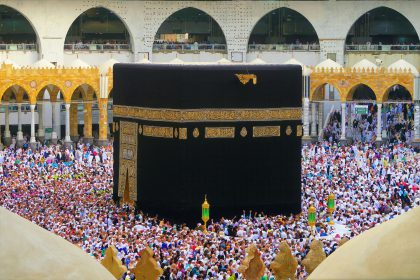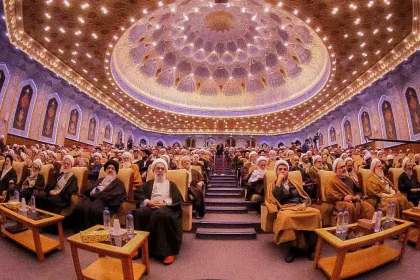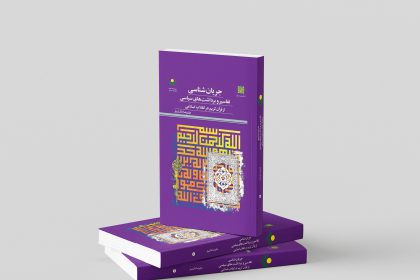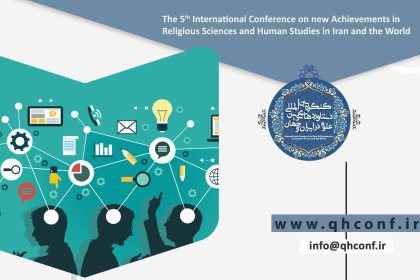- Abstract
- Introduction
- What is meant by Selective Collection and Unbalanced Presentation?
- Cases of Selective Data Collection
- Apparition (1:124)
- Al-Aqsa Mosque (1:25)
- Abrogation (1:11)
- Azar (1:192)
- Cain and Abel (1:270)
- Friday Prayer (2:271)
- Exegesis of the Qurān: Classical and Medieval (2:99)
- Ambiguous (1:70)
- Unbalanced Data Presentation
- Conclusion
Abstract
The Encyclopedia of the Qurʾān (Leiden) represents one of the most recent contributions to the Western tradition of Islamic Studies. As such, it exhibits many of the typical features that have long characterized this field. Despite the diversity of contributors, the encyclopedia is shaped by overarching methodological frameworks that inform the content and guide the analysis across many of its entries.
This study aims to identify and examine some of these frameworks by highlighting recurring patterns of selective data collection and unbalanced data presentation, which frequently lead to the formation of misleading analyses. It further argues that the application of such methodological approaches—whether in the study of a religious tradition, a modern secular legal system, or even a philosophical school—inevitably results in distorted or even absurd representations.
Given that these issues—and critiques of them—have persisted for centuries within debates surrounding Western Orientalism, the study proposes the well-known hypothesis that “scientific paradigms guide research” as one key explanation for the resistance within Western discipline of Islamic Studies to certain scholarly corrections or reforms.
Keywords: Encyclopaedia of the Qurʾān, Islamic Studies, Qur’anic Studies, Orientalism, Selective Methodology, Scientific Objectivism, Subconscious Presuppositions
Introduction
The relatively long-standing tradition of Western Orientalism in general—and Islamic studies in particular—has, almost since its inception, received mixed reactions from Muslims. These responses range from those who view the field as the most rigorous and scientific attempt to understand Islamic tradition—one that should be adopted by Muslim scholars as a model of true academic methodology—to those who see it as a tool of Western imperialism, deeply embedded in colonial and post-colonial agendas of domination.
By examining key methodological frameworks in the Encyclopedia of the Qurʾān (EQ), the present study argues that, beyond political motives or the sincere intentions of individual scholars, the field—exemplified here by EQ—suffers from serious methodological shortcomings. While it is common for academic disciplines to face limitations, which are often addressed through critical and peer-reviewed engagement, the deficiencies discussed in this study are more difficult to remedy. This is partly because what critics view as flaws are often perceived by practitioners within the field as scholarly virtues rather than problems.
The study consists of two main sections followed by a conclusion. The first section presents some examples of biased data collection in EQ. The second discusses instances of unbalanced data presentation. Finally, the study offers its main conclusion: a response to the question of the origin and persistence of these methodological issues. Put simply, it asks why such consistent partiality continues to recur—despite longstanding critique—in a discipline that is meant to uphold the standards of objective scholarship.
What is meant by Selective Collection and Unbalanced Presentation?
In brief and simple terms, this paper defines selective collection of research materials as a methodological flaw wherein a researcher—often due to personal presuppositions, either consciously or unconsciously—disregards certain facts that contradict a pre-established theory. For instance, when a significant number of Muslim scholars hold a particular view, yet a researcher overlooks or omits them entirely. A common example of this in the Encyclopedia of the Qurʾān (EQ) is the treatment of Shiʿa exegetical perspectives, which are frequently ignored as if they do not exist—despite the inclusion of views from even marginal or cult-like groups.
Unbalanced data presentation, on the other hand, refers to the unequal or distorted representation of various elements within a theological, philosophical, or historical framework. For example, the centrality of the doctrine of Tawḥīd (monotheism) in Islamic theology—with its deep, multi-layered implications—has no true equivalent in many other religious systems. Presenting it alongside other doctrines as merely one among many religious teachings misrepresents its unique theological weight. Similarly, if there are nine traditionally authentic and objectively reliable accounts of a historical event, and only one obscure and questionable report offers an alternative version, highlighting that single unreliable report as the cornerstone of one’s historical interpretation constitutes a clear case of unbalanced data presentation.
Cases of Selective Data Collection
Apparition (1:124)
After defining apparition as “a preternatural appearance of a specter or vision,” the entry states, “There is no specific Qur’ānic term for apparition.” This assertion overlooks the clear and explicit Qur’anic term tamaththul (Qur’an 19:17), along with its rich exegetical and philosophical elaborations—not to mention its widespread use in Hadith literature (Tabatabaei, 1417, p. 14:36). Strangely, instead of engaging with tamaththul, the author redirects attention to two unrelated terms: burhān (proof) and āya (sign), in an attempt to locate a Qur’anic basis for the concept of apparition. Given the substantial lexical and semantic differences between these terms and “apparition,” the rationale for this choice raises questions.
The reason soon becomes apparent: based on a particular interpretation influenced by Isrā’īliyyāt, the word burhān in 12:24 is claimed to refer to an apparition. This interpretation has parallels in the Babylonian Talmud, and thus supports a broader theory suggesting the Qur’an’s dependence on earlier biblical traditions—a theory often advanced in Western anti-Islam rhetoric. The neglect of the Qur’anic term tamaththul in favor of such an indirect and speculative association reveals a methodological bias.
Furthermore, the entry goes on to discuss cases of illusion and optical error within the same context, effectively blurring the lines between prophetic vision and satanic hallucination—yet another recurring theme in certain Western readings of the Qur’an and the Prophet who conveyed it.
Al-Aqsa Mosque (1:25)
“Within Muhammad’s lifetime… ‘the farthest (al-aqṣā) place of prayer’ might have been in heaven, in Jerusalem (q.v.), or perhaps in a locale near Mecca.” According to the author, there is no evidence in the Islamic exegetical tradition to interpret the Qur’anic term Masjid al-Aqṣā, nor sufficient indication of when Muslim writers first began to associate it with Jerusalem: “Only at a later, unknown time did the topographical attribution become the proper name of the Aqṣā Mosque.” She then continues: “No Muslim source records the Ḥaram’s first mosque… but the Gallic pilgrim Arculf saw that the ‘Saracens’ had a rough prayer house, unnamed, in its eastern part… That mosque has been attributed to ʿUmar b. al-Khaṭṭāb” (1:125). She proceeds to list the various renovations and expansions of the structure throughout history, specifying who should be credited for each phase of its development.
Moreover, the author makes a point of stating that Muslim historians’ and geographers’ detailed descriptions of al-Aqṣā are “sometimes contradictory,” while emphasizing that “Hamilton’s study provides the most complete archaeological record” (1:126). In summary, because no building referred to as a masjid existed in Jerusalem during the time of the Qur’anic revelation, the term Masjid al-Aqṣā is treated as vague. Only later—though exactly when and by whom remains unknown—was the term applied to a specific structure allegedly attributed to the second caliph. In effect, this reading implies that the Qur’anic verse in question (17:1) was originally ambiguous and meaningless to Muslims, including the Prophet (s) himself; it could have referred to any location—celestial or terrestrial, Arabian or Levantine—until a later generation erected a building in Jerusalem and retroactively applied the name.
One is left wondering whether this interpretive approach stems from a basic but critical misunderstanding between “mosque” as a building and “mosque” as a sanctified piece of land. A quick survey of early Islamic sources reveals that the term masjid was at times used to refer to a plot of consecrated ground, not necessarily a built structure. Therefore, the absence of a mosque-building in Jerusalem at the time does not render Qur’an 17:1—or the numerous Hadiths referencing Masjid al-Aqṣā—inherently vague. Furthermore, according to Islamic historical tradition, places of worship established by prophets are considered legitimate masjids: Adam (a) built the Kaʿba; David (a) designated the site of Masjid al-Aqṣā (later constructed by Solomon (a) and identified in biblical literature as Solomon’s Temple); and Muhammad (s) established the mosque in Medina. Indeed, the plural title Masājid al-Anbiyāʾ (Mosques of the Prophets) is used in early Islamic tradition to refer to these three, acknowledging their divine and prophetic origins (al-Jaṣṣāṣ, 1405, p. 1:302).
Abrogation (1:11)
In a reversed and overly negative framing, the concept of abrogation is introduced not as the natural outcome of any flexible and gradual legislative process, but rather as “a concept… which allowed the harmonization of apparent contradictions in legal rulings.” This definition gives the impression that the Qur’an originally contained contradictions, and that Muslim scholars later devised the notion of naskh (abrogation) to resolve them. While it is true that abrogation may serve that function from a later analytical perspective, defining it primarily as a tool to justify discrepancies in a legal text misrepresents the concept. Such a portrayal overlooks its foundational role as an intrinsic part of Qur’anic legislative development, rather than a reactionary mechanism to resolve inconsistency.
Azar (1:192)
Completely ignoring—whether deliberately or inadvertently—the strong Shia interpretation of the verses related to Azar, which reject him as Abraham’s (Ibrāhīm’s) father, the author attempts to reconcile the discrepancy between the name of Abraham’s father in the biblical tradition (Terah) and the name mentioned in the Qur’an (Azar), as understood in the non-Shia interpretation. The author states: “The most widely accepted view… is that the name derives from the Hebrew Ely’ezer, the name of Abraham’s servant in Gen. 15:2,” and goes on to suggest that “it also indicates an inability among early Muslims to differentiate Abraham’s father from his servant in the biblical account.” Clearly, had the author taken Shia views into account, at least some early—and later—Muslims could have been spared such accusations of confusion or incompetence.
What makes the omission even more questionable is the fact that in other contexts, the authors of the work often go to great lengths to include even the most obscure ideas and present them as mainstream or orthodox Shia beliefs—such as in the case of Shia views on taḥrīf (the distortion of the Qur’an).
Cain and Abel (1:270)
It is striking how the clear distinction between the Qur’anic and biblical narratives of Abel’s burial is overlooked. The detail that God sent a raven to teach Cain how to bury his brother’s body is a uniquely Qur’anic element—entirely absent from biblical tradition—yet this significant divergence receives no attention from the author. Instead, he confidently attributes the passivity of Abel in Qur’an 5:28 to Christian influence, without citing any explicit or implicit reference from Muslim sources: “Abel’s inaction and passivity (cf. Q 5:28) is evidently a Christian element since, according to Christian tradition, the murder (q.v.) of Abel is considered a prefiguration of the crucifixion of Jesus.” (1:271)
According to this interpretation, Qur’an 5:28 contains an “evident” Christian element—not because Muslim exegetical sources make such a claim, but solely because Christian tradition views Abel’s murder as a foreshadowing of Jesus’ crucifixion. The author seems to overlook the fact that the Qur’an explicitly and emphatically rejects the crucifixion account altogether (Q 4:157), making the proposed connection not only speculative but internally inconsistent with the Qur’anic worldview.
Friday Prayer (2:271)
Jumʿa (Friday) is introduced as the sixth day of the week—but the text fails to clarify: whose week? Muslim or Jewish? It then claims that the name Jumʿa (“Assembly”) is derived from a Jewish custom of market-gathering on Fridays. Thus, the designation of Friday as the Muslim day of congregational prayer is portrayed as a “juxtaposition of market activity and collective religious duty.” As the entry continues, it is argued that Friday was not initially set apart as a day of rest, and that its establishment as a day of communal prayer had no polemical intent. According to the author, only in later developments did Friday emerge as a religious counterpart to the Jewish Saturday or Christian Sunday.
Let us address these claims in order. First, it is important to note that the pre-Islamic name for Friday was not Jumʿa or “Assembly” in connection with Jewish customs. Rather, the day was known as Yawm al-ʿArūba—the Day of Arabism. Some of the earliest fragments of pre-Islamic Arabic poetry use the name al-ʿArūba[1] rather than Jumʿa.[2] Indeed, early Arab lexicographers and writers explicitly state that prior to Islam, no one used the name Jumʿa for Friday.[3]
Secondly, some of the earliest and most authoritative traditional accounts accompanying Qur’an 62:9 clearly state the polemical intent behind assigning Friday as the Muslim congregational day—in distinction to the Jewish Sabbath and the Christian Sunday.[4] It is also worth clarifying that Islam does not recognize the concept of a “day of rest” in the way Judaism or Christianity might. The Qur’an explicitly rejects the notion that God rested after the six days of creation (Q 50:38), making the expectation of a rest-day misplaced within Islamic theology. However, Muslims are strongly encouraged to temporarily leave off trade and work to attend congregational worship—not for rest, but for the purpose of devotion (Q 62:9).
The author then cites this verse as evidence that the ritual takes place in the proximity of social and commercial activity. Yet, he himself admits that in pre-Islamic Arabia, market activity typically declined by midday. This presents a contradiction in his argument: if market gatherings dwindled before the Friday noon prayer, then the instruction to “seek the bounty of God” after prayer (Q 62:10) cannot reasonably be linked to market activity that had already ended.
Finally, the entry concludes with a questionable chronological assertion. The author rejects the traditional interpretation of Q 62:11—that some companions left the Prophet (s) standing during his sermon—on the grounds that the Hadith used in this interpretation mentions the minbar (pulpit), which he claims did not exist at that time. This assertion is presented as self-evident truth.
However, any reader with even a basic familiarity with Islamic history would question such a claim. The bibliography cites “The Pulpit in Islam” by S. M. Zwemer—a 13-page paper that actually confirms the existence and use of the minbar during the Prophet’s lifetime, based on traditional sources (Zwemer, 1933). Where in this paper it supposedly denies the Prophet’s use of a minbar is unclear.
In fact, historical references to the minbar during the Prophet’s time are numerous and diverse—too many to be dismissed as “later Muslim fabrication,” as is often the case with Western Orientalist skepticism. Furthermore, even if the particular Hadith cited in the exegesis of Q 62:11 mentions the minbar (which the author mistakenly assumes to be anachronistic), there are other Hadith and early accounts that describe the Prophet delivering sermons while standing, without referencing a minbar.[5] Ignoring these accounts merely to support a predetermined theory reflects a selective and biased methodology.
Exegesis of the Qurān: Classical and Medieval (2:99)
In this entry, we are told that the technical sense of the word tafsīr has no origin in the Qur’an itself and, like almost everything else in early Islamic literature, it was supposedly plagiarized from Judeo-Christian tradition. And why is that? Because the word tafsīr appears only once in the Qur’an (hapax legomenon) and is primarily linked with the meanings of “unveiling” or “uncovering,” the author explains.
First of all, even if it (the word tafsir) had been repeated a hundred times in the Qur’an, it would still not preclude the typical orientalist tendency to accuse the Qur’an of plagiarism—an accusation that often serves as a default position, invoked freely and without the burden of substantial evidence.
Second, is it not possible for a single word in scripture to inspire the emergence of an entire scholarly tradition? And why the clear connection between the original etymological sense (unveiling or uncovering) and the technical sense (interpretation) is so easily dismissed?
The discussion then shifts to taʾwīl, which is used multiple times in the Qur’an. But again, as per the author’s approach, its meaning and contrast to tafsīr is reduced to an echo of Jewish and patristic discussions of the fourfold method of scriptural interpretation. While space does not permit a full analysis of the significant differences between the tafsīr/taʾwīl dichotomy in Islamic tradition and the Christian fourfold exegesis (primarily developed by Alexandrian theologians), even a cursory look at the Qur’anic use of taʾwīl and its elaboration in Muslim exegetical literature reveals the unique dimensions of its Islamic development.
One example will suffice. The author claims: “It has recently been definitively shown that the verb taʾawwala, from which the term taʾwīl is derived, originally meant ‘to apply a verse to a given situation,’ before it came to mean allegorical interpretation” (2:100). However, one of the very usages of taʾwīl in the Qur’an not only reveals that this “recent discovery” is hardly new, but also clarifies the consistency between the etymological and technical meanings of taʾwīl, and affirms its distinctiveness from what is known as allegorical interpretation in the Judeo-Christian tradition.
As the author briefly notes from early Arabic lexicons, taʾwīl etymologically means “returning to the origin.” What is overlooked, however, is that “origin” (awwāl) in this context is best understood in the sense of the Greek archē—not merely a chronological or spatial beginning, but a prototype or metaphysical root. The application of a text to, and its return toward, an archetypal metaphysical source of meaning is what defines an interpretation as -so called- allegorical.
A clear example of both the etymological and technical meanings appears in Qur’an 12:100. When Joseph (Yūsuf) is finally raised to power and his family bows to him in recognition, he says: “This is the taʾwīl (realization) of my earlier dream. My Lord has made it a reality.” In this instance, taʾwīl is the process by which a symbolic sign (the dream) is linked to its actualized form or prototype (the event), thus validating the original meaning. The act of taʾwīl here is not metaphorical embellishment, but interpretive realization—a matching of sign and archetype.
In Qur’anic exegesis, a Muslim who regards the āyāt (a better translation than “verses,” as āyah means “sign”) as derived from a higher origin (cf. Q 11:1) aims to uncover the original referents of these signs. When the sign is correctly matched with its referent, one claims to have arrived at its proper taʾwīl—not in the sense of inventing new meaning, but in the sense of returning the sign to its intended prototype. While at times this prototype may appear distant or obscure, leading some to label the method “allegorical,” such a judgment arises from a limited perspective. To the practitioner of taʾwīl, the process is not about symbolic substitution but faithful application.
Of course, the discourse surrounding taʾwīl, its various senses, and its historical development is vast and complex. This brief paper simply aims to highlight that explicit traces of this integrative understanding—linking etymological and technical meanings—exist in the earliest strata of Muslim exegetical literature. Why the author would dismiss this longstanding explanation and instead claim both a modern origin for the notion of application and an inherent disconnect between the term’s root and technical usage remains unclear.
Ambiguous (1:70)
In this entry, we read: “Al-Zarkashī (d. 794/1392), citing al-Nisaburi, argues that these passages (Qur’an 3:7; 39:23; and 11:1) present three different statements on the nature of the Qur’ān.” This suggests that al-Zarkashī acknowledged the apparent tension between these verses. It is then stated, “He characterizes the verse that supports the idea of the compound nature [of the Qur’an],” implying that al-Zarkashī arbitrarily sides with one verse in this supposed contradiction. The impression given is that the Qur’anic verses contradict one another, and a Muslim commentator simply picks a side at random.
However, we will not delve here into the broader Muslim exegetical tradition and its nuanced treatments of the term mutashābih. Instead, we will focus specifically on what al-Zarkashī actually wrote. Did he believe that these verses present fundamentally contradictory statements, and did he simply choose one over the others?
Al-Zarkashī writes: “Al-Nisaburi cites three opinions on this matter. The first holds that the entire Qur’an is unambiguous, based on verse 11:1. The second asserts that it is entirely ambiguous, based on verse 39:23. The third opinion—which is the correct one—maintains that some parts of the Qur’an are unambiguous and some are ambiguous, based on verse 3:7.”
Clearly, al-Zarkashī and al-Nisaburi are presenting differing exegetical opinions derived from these verses. They defend the interpretation they believe to be correct, rather than arbitrarily favoring one verse while dismissing the others. They do not “characterize” a verse to support a particular idea, nor do they reject or invalidate any Qur’anic verse. Rather, they critique and refute two of the interpretive opinions associated with those verses, not the verses themselves.
Unbalanced Data Presentation
Unbalanced data presentation refers to the disproportionate emphasis given to certain elements in an analysis—treating marginal data as central while neglecting the mainstream, pivotal narrative. In some fields, such an approach may be valuable, offering alternative or creative perspectives. However, in other areas of research, particularly when dealing with historical or religious traditions, scholars cannot afford to disregard the relative weight of each element within its original context.
For example, if I aim to study Christianity as a historical phenomenon with social, political, and spiritual dimensions, I cannot present a few lines from apocryphal sources as if they reflect mainstream Christian belief—then claim my portrayal is objective and unbiased. The pseudo-scientific claim that “practitioners of Christianity are biased in their understanding, but my treatment is objective” does not justify such a caricature. Scholarly integrity requires that the portrayal of any tradition be based on what its adherents themselves regard as central versus marginal. By elevating the peripheral and sidelining the core, I would not only betray the foundational aim of my research but also likely distort the internal coherence of the phenomenon in favor of my own preconceived theories.
A quick survey of the encyclopedia in question reveals a similar imbalance. Major topics and critical discussions are often glossed over, while minor or marginal subjects are treated at length. For instance, in the entry Hadith and the Qur’an (2:376), we read that, according to “Western investigators,” the isnāds (chains of transmission—one of the primary tools for authenticating early Islamic tradition) “are better left alone, inasmuch as not only a good number — as is generally admitted — but, conceivably, all of them may be forged.” The author somewhat tempers this extreme view by promising to be only “less radically skeptical.” Nonetheless, the article goes on to indulge in extended discussions on typical orientalist favorites, such as the beginning of revelation and the traditions regarding the “Seven Letters.”
Despite broadly dismissing the isnāds of Islamic traditions as wholesale fabrications, orientalists paradoxically treat select reports in these specific areas as historical facts. Why? Simply because these reports—however tenuously—can be interpreted as supporting their theory that the Qur’an has non-divine origins. Even indirect or obscure traces that might point in that direction are given undue emphasis.
At the same time, significant topics such as Isrāʾīliyyāt—a term used by Muslim scholars to refer to biblical or Judaic elements that entered Islamic tradition—are omitted altogether. This topic reflects an early and conscious effort by Muslim scholars to define the originality of their tradition and to establish boundaries between Islamic teachings and Judeo-Christian narratives. Yet, in this voluminous encyclopedia—which contains full-length entries on topics such as dog, donkey, and Druze—Isrāʾīliyyāt does not merit inclusion. Why? Because it challenges the orientalist narrative that Islam is merely a derivative of earlier Abrahamic faiths, plagiarized by unlearned desert Arabs who were allegedly unaware of what they were compiling.
According to this narrative, Islam arose in a tribal society obsessed only with war, wine, and women. Then, within a few decades, these same people supposedly developed sophisticated systems of theology, historiography, and literature—while also becoming critically aware of external influences on their tradition and actively working to preserve its originality. That Muslims discussed and addressed topics like Isrāʾīliyyāt undermines the simplistic orientalist view and is therefore conveniently ignored.
What is unique about the Islamic tradition is that, unlike the Judeo-Christian tradition—where decisions regarding what is canonical or apocryphal were often made in remote historical moments and behind closed doors—Muslim scholars, from the earliest periods, developed and openly documented methods for authenticating and rejecting reports of religious teachings (Hadith). These debates occurred publicly, through transmitted oral accounts and written texts in widely circulated books—not in secret councils or private deliberations.
Although Islam lacks a centralized, Church-like authority, it has always maintained clear techniques and methodological frameworks for the systematic verification or dismissal of traditional reports. To ignore the distinction between authentic and fabricated, canonical and apocryphal, and then attempt to produce so-called “objective” research on that basis, results in a portrayal that reflects neither a coherent religious tradition nor an accurate historical phenomenon.
What would happen if we applied the same flawed approach to Christianity? If we mixed canonical and apocryphal texts and constructed a belief system from that blend, would it produce an objective picture of Christianity—or simply a patchwork of narratives tailored to support a pre-established theory?
Conclusion
So far, we have discussed several instances of selective data collection and unbalanced data presentation. But what are the broader consequences of applying such methodological frameworks when attempting to understand a theological, philosophical, or legal system? Concrete illustrations—such as how Christian theology, Buddhist tradition, Kantian philosophy, or the American legal system would appear under similar treatment—could help make these deficiencies more apparent, particularly to a Western audience.
What would happen if, like a gossip columnist, a researcher dedicated the majority of their analysis to marginal or controversial issues within these systems and portrayed them as central? In large part, this is precisely the attitude we observe in much of the Western orientalist tradition and modern Islamic Studies: a long-standing fascination with the controversial or obscure, coupled with a consistent neglect of the mainstream, coherent dimensions of Islamic theology, law, and philosophy.
There may be various reasons for such behavior at different levels of scholarship. However, one underlying factor appears especially influential. As philosopher of science Thomas Kuhn observed, “Paradigms guide research by direct modeling as well as through abstracted rules” (Kuhn, 1996, p. 47). This observation is particularly relevant to the Western academic study of foreign cultures and religions, including Islam. Since its emergence, Islam has often been met with hostile and biased reactions in the West—initially fueled by religious motivations prevalent in medieval Europe. Strikingly, this early bias did not disappear with the Renaissance or Enlightenment; rather, it persisted through the colonial and post-colonial periods, merely adopting new forms.
The core assumption—that Islam is devoid of originality and merely an incoherent plagiarism of earlier traditions—has survived Europe’s major social, political, and intellectual revolutions. It has remained, consciously or unconsciously, a guiding framework for much of the Western academic approach to Islam. As a result, both data collection and data presentation in Western-developed Islamic studies often follow problematic patterns, several of which have been identified in this paper.
This is dangerous for two main reasons. First, just as selective reporting in Western journalism distorts public perceptions of Muslims—deepening social divisions, reinforcing stereotypes, and fueling reactive radicalism—selectivity in academic research on Islam and its intellectual heritage has similar consequences. Second, the longevity of these inherited paradigms—strengthened during the colonial era and maintained through successive generations—makes scholarly correction extremely difficult and slow. This challenge is compounded by the fact that many of the practitioners sincerely believe they are being objective and unbiased.
The practical result of this belief is the perceived liberty to approach Islamic tradition not as a serious and complex intellectual heritage, but rather in the manner of a gossip columnist—highlighting the sensational and marginal while sidelining the substantive and mainstream.
[1] – Jawad Ali believes this name comes from “Erib Shebat” meaning the eve before Saturday in Hebrew. (علی 1993، 8:468) this displays clear pre-Islamic Jewish influence, yet no sense of assembly or market-gathering is there.
[2] – نفسي الفداء لأقوامٍ همو خلطوا … يوم العَرُوبة أزواداً بأزوادِ. (الشافعی 2006، 3:1356؛ علی 1993، 8:465)
[3] – ذكر السهيلي في الرَّوْض الأُنُف أَنَّ كعب بن لؤيّ أَوّلُ من جَمَّع يوم العَرُوبةِ، و لم تسمَّ العَروبةُ الجُمعة إِلا مُذ جاء الإِسلام. (ابن منظور 1414، 8:58)
[4]– “you and your nation have been preferred over other nations by Friday” (الشافعی 1400، 70) “Jews envied us for Friday” (ابن اثیر 1994، 5:75) and “ God written [commemoration of] Friday upon previous nations, they disagreed, but we were guided to it” (ابن راهویه 1991، 1:125) “get ready for Friday from Thursday eve, like the way Jews get ready for Saturday from Friday eve.” (مجلسی 1403، 54:211، 86:197)
[5] – see: (احمد بن حنبل 2001، ۲۲:۲۵۶) (مسلم 1412، ۲:۵۹۰، ۲:۵۹۱) (الترمذی 1419، ۵:۲۵۰) (القمی 1404، ۲:۳۶۷)








Salam
thanks for the good read